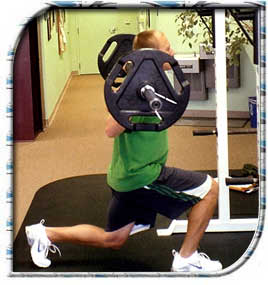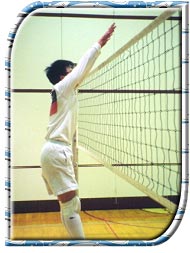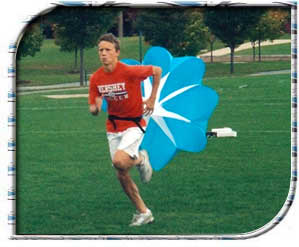Training Components of a Strength & Conditioning Program
- Sports Appropriate Resistance Training
- Plyometrics (Speed-Strength Training)
- Core training (Abdominals/Obliques/Low Back)
- SAQ (Speed/Agility/Quickness)
- Footwork & Balance
- Metabolic Training
- Flexibility(Sports Specific)
- Sports Nutrition (In the Zone)

This is a specialized resistance training approach to prepare your body for the demands of a specific sport. While athletes initially start the off-season with non-specific resistance training exercises to build a base development, the focus of resistance training eventually needs to be determined by the demands of the sport. Sitting down and performing leg extensions might help build strength, but it is not functional strength. After all, sports are not played sitting in a chair. All sports require multi-joint muscular actions across multi-planes of movement. Most sports are also ground-based activities, so athletes need to use exercises that will enable them to apply force against the ground with their feet. The idea is to utilize resistance training exercises, which will best transfer to the actual playing conditions of that particular sport.

An athlete utilizes plyometric exercises to train muscles to reach maximum strength in as short a time as possible, or simply put uses plyometrics to develop explosive power. Plyometrics involve techniques and training programs for optimizing the use of the stretch-shortening cycle, which are important for developing superior performance in athletics. Lower body plyometric exercises are utilized to develop quick feet movement, and the ability to quickly get off the ground. Lower body plyometric exercises include jumps-in-place, standing jumps, multiple hops & jumps, bounding, box drills, and depth jumps. Upper body plyometric exercises involve the use of medicine balls to train the muscles to respond to external forces more quickly.
 All
force generated by the musculoskeletal system in the upper and
lower body either originates, is stabilized by, or is transferred
through the trunk and low torso. Given this fact, if athletes
are to develop their full strength and power potential, then
a significant portion of a strength & conditioning program
should focus on the abdominals/obliques/low back. A good example
of this are athletes who have a strong, powerful lower body,
but do not reach full potential in vertical jumping due to weakness
in the core part of the body.
All
force generated by the musculoskeletal system in the upper and
lower body either originates, is stabilized by, or is transferred
through the trunk and low torso. Given this fact, if athletes
are to develop their full strength and power potential, then
a significant portion of a strength & conditioning program
should focus on the abdominals/obliques/low back. A good example
of this are athletes who have a strong, powerful lower body,
but do not reach full potential in vertical jumping due to weakness
in the core part of the body.
 Speed
is the ability to cover a certain distance from point A to point
B in the shortest time possible. The two primary components of
speed are acceleration and top speed. Acceleration is defined
by how much time it takes to reach top speed. Top speed is defined
as the most possible yards per second a person can run. Speed
is the product of stride length and stride frequency. Stride
length is the distance covered with each step during a run. Stride
frequency is the number of steps taken per second. A well rounded
speed training program will target the improvement of both stride
length and stride frequency, along with correct running technique.
An additional component of speed that needs to be considered
for several sports is speed endurance. Improving speed endurance
will prevent the athlete from slowing down in the later stages
of a game or near the finish of a long sprint. For most sports,
acceleration is more crucial for the athlete than speed itself.
A running back in football might have blazing speed, but the
best running backs have great acceleration, which enables them
to hit a hole before it closes. Agility is the ability to accelerate,
decelerate, and quickly change direction while maintaining good
body control. Quickness is determined by the athlete's ability
to perform specific movements in the shortest possible time.
Quickness is also determined by the ability of the nervous system
to process and produce rapid contractions and relaxations of
the muscle fibers. Quickness is a key component for fast, explosive
movements of the whole body, which occur during the starting
and acceleration phases of sprinting. It is also an important
factor when a body part needs to start a new movement or rapidly
change direction.
Speed
is the ability to cover a certain distance from point A to point
B in the shortest time possible. The two primary components of
speed are acceleration and top speed. Acceleration is defined
by how much time it takes to reach top speed. Top speed is defined
as the most possible yards per second a person can run. Speed
is the product of stride length and stride frequency. Stride
length is the distance covered with each step during a run. Stride
frequency is the number of steps taken per second. A well rounded
speed training program will target the improvement of both stride
length and stride frequency, along with correct running technique.
An additional component of speed that needs to be considered
for several sports is speed endurance. Improving speed endurance
will prevent the athlete from slowing down in the later stages
of a game or near the finish of a long sprint. For most sports,
acceleration is more crucial for the athlete than speed itself.
A running back in football might have blazing speed, but the
best running backs have great acceleration, which enables them
to hit a hole before it closes. Agility is the ability to accelerate,
decelerate, and quickly change direction while maintaining good
body control. Quickness is determined by the athlete's ability
to perform specific movements in the shortest possible time.
Quickness is also determined by the ability of the nervous system
to process and produce rapid contractions and relaxations of
the muscle fibers. Quickness is a key component for fast, explosive
movements of the whole body, which occur during the starting
and acceleration phases of sprinting. It is also an important
factor when a body part needs to start a new movement or rapidly
change direction.
 The
objective of correct footwork is to gain a step. It is vital
for the athlete to not take a false step, which is defined as
taking a step away from the intended direction of movement. This
is the most common footwork error. Footwork involves quickness
and control of the feet during athletic movements. Without good
footwork, it is impossible to be a good athlete. Balance is the
ability to regulate shifts in your body's center of gravity while
maintaining control. Balance is the single most important component
of athletic ability because it underlies all movement whether,
that movement is dominated by strength, speed, flexibility, or
stamina. Because athletes are constantly moving, it is vital
to develop balance not from a stationary standpoint, but while
the body is in motion.
The
objective of correct footwork is to gain a step. It is vital
for the athlete to not take a false step, which is defined as
taking a step away from the intended direction of movement. This
is the most common footwork error. Footwork involves quickness
and control of the feet during athletic movements. Without good
footwork, it is impossible to be a good athlete. Balance is the
ability to regulate shifts in your body's center of gravity while
maintaining control. Balance is the single most important component
of athletic ability because it underlies all movement whether,
that movement is dominated by strength, speed, flexibility, or
stamina. Because athletes are constantly moving, it is vital
to develop balance not from a stationary standpoint, but while
the body is in motion.
Metabolic training prepares the body to best utilize the energy sources, which are needed for a particular sport. The two types of metabolic training are anaerobic training and aerobic training. Anaerobic training consists of the phosphagen system (instant energy source) and the glycolysis system(lactic acid). Athletic events that are short in duration(5-30 seconds), rely primarily on the phosphagen system. Athletic events, which are 30-90 seconds in duration, rely primarily on the lactic acid system. Aerobic training is used for athletic events, which are 90 seconds or longer in duration. For athletes in power sports, it can be detrimental to train aerobically as this type of training will lead to a decrease in power and strength. However, interval training, which primarily will improve the stored phosphagen and lactic acid systems, can also secondarily benefit the aerobic system. All three energy systems are used at any time, however the energy system, which is primarily used during that time is determined by the intensity and duration of the athletic activity.

All serious athletes need to make stretching a vital component of their strength & conditioning program. Sports specific stretching benefits the learning, practice, and performance of several skilled movements. A proper stretching program may also decrease the possibility of musculotendinous and joint injuries. The stretches utilized by athletes should be relevant to the needs and demands of their particular sport.

Nutritional advice for athletes use general guidelines from the book, 'Eat, Drink, and Be Healthy-The Harvard Medical School Guide to Healthy Eating' by Walter C. Willett, M.D. It is a science-based book on nutrition that you can trust. Athletes will be encouraged to eat more healthy carbohydrates(fruits and vegetables) that do not cause fatigue, healthy sources of protein(white meat chicken and fish), and healthy choices of monosaturated fats(variety of nuts).









